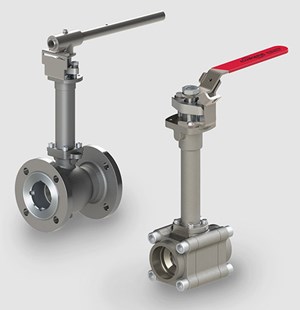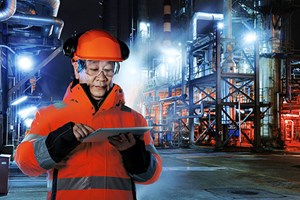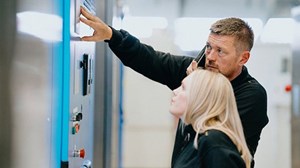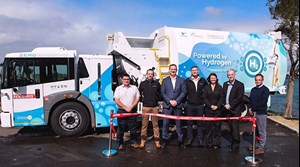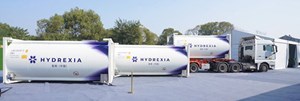Articles
H2Tech: Tech Spotlight
T. CAMPBELL, Managing Editor
H2 EQUIPMENT
DEKRA receives approval for all key services relating to hydrogen (H2) refueling stations
DEKRA is one of the first testing organizations to receive approval for all key services relating to H2 refueling stations (HRSs). Commissioned by refueling station operators, DEKRA experts can certify a facility’s compliance with all applicable safety standards and the H2 quality they deliver.
In summer 2023, DEKRA was authorized by the CEP to independently test and certify H2 refueling stations in accordance with ISO 19880-1c. This puts DEKRA among the first recognized testing organizations to be authorized by the CEP for this task. DEKRA already has a fixed supply agreement with the Ulm-based Center for Solar Energy and H2 Research Baden-Württemberg (ZSW) for the testing—including acceptance testing—of refueling stations.
Impurities in H2 can damage the fuel cells in vehicles, so the H2 sold at refueling stations in Germany must meet the standards defined in DIN EN 17124, which is required by carmakers. As a new service, DEKRA is also offering the testing and confirmation of H2 quality at the pump. DEKRA already has the first confirmed clients for its testing services to ensure safe refueling in accordance with the International Organization for Standardization (ISO) 19880-1c. DEKRA has fixed supply agreements with the ZSW and the Duisburg-based H2 and Fuel Cell Center to test H2 quality and perform acceptance testing at refueling stations.
Flowserve introduces Worcester® cryogenic ball valves to help control fugitive emissions
Flowserve Corp. has launched the Worcester cryogenic series of reduced-port, quarter-turn floating ball valves that offer superior reliability in liquefied natural gas (LNG), H2 and other industrial gas and cryogenic applications.
Available in three-piece (CF44 series) and flanged (CF51/CF52 series) configurations, Worcester cryogenic valves feature a high-strength stem and provide exceptional fugitive emissions control from an improved live-loaded stem seal. They also incorporate a modular bolted bonnet design, which provides customers with cost-effective flexibility and enables them to reduce spare parts inventories, reducing the total cost of ownership (TCO).
Worcester cryogenic valves can be key enablers in several industries, including aerospace, food and beverage, defense, pharmaceutical, petrochemical, steel and biofuels. They can also be utilized for LNG applications including gasification, loading and unloading, processing, refrigeration and transportation. They are designed to meet requirements for processes involving H2, nitrogen, oxygen and ammonia.
The redesigned bonnet configuration offers robust stem sealing for fugitive emissions compliance throughout the thermal ranges. Live loading ensures a long service life and continued compliance. The high-strength stem improves reliability, extends service life and provides for increased maximum allowable stem torque while complying with the American Petroleum Institute (API) 608 and the ISO 17292.
Alfa Laval addresses heat exchanger choice in H2 market with online tool
Alfa Laval is addressing the challenge of choice in the H2 industry’s heat exchanger market with a key appointment to its energy division and the launch of its new online design and specification tool, HEXpert.
Recent market reports forecast the global heat exchanger market to increase at a compound annual growth rate (CAGR) of 6% from 2022–2031, reaching $34.24 B, demonstrating the technology’s anticipated critical role in H2 applications. Given this pronounced growth, equipment specifiers will be under increasing pressure to identify the correct solution as differing designs and solutions flood the market, to ensure their plant remains as reliable, sustainable and efficient as possible.
Alfa Laval will be spearheading a new company team dedicated to optimizing plant operations in new and established industries. The goal is to ensure the availability of key performance information crucial to choosing effective solutions for specific H2 plant applications. The company believes online resources have a key role to play in this.
Using HEXpert, specifiers enter information about their operations and heat transfer requirements in a four-step process, starting with adding information about the exchanger position. Further steps involve providing specific details on design parameters and application demands through a question-and-answer format, before providing a full and detailed product recommendation.
H2 APPLICATIONS INNOVATION
HAV Hydrogen and NES complete test of H2 fuel cell with control system
HAV Hydrogen and Norwegian Electric Systems (NES) have completed a successful laboratory test of a H2 fuel cell in combination with a maritime control system. The successful test is a continuation of the FreeCO2ast project that has developed a high-capacity H2-based energy system that can be retrofitted onboard ships.
The scope of the project was to test NES’ proprietary control system and interface with a H2 fuel cell and associated drives, including validation of the system design, software and hardware. In addition, control, safety systems and barriers for the integration of the fuel cells were tested. In the test, the H2 fuel cell was benchmarked against a meticulously simulated load profile, developed using advanced simulation tools from the groundbreaking FreeCO2ast project.
The successful test was conducted in cooperation with Clara Venture Labs, hosted by Sustainable Energy at its Energy House test facility at Stord, Norway. Independent research institute Sintef Ocean, which developed the test’s simulation model, was also a project partner. The test is a continuation of the FreeCO2ast project that has developed a high-capacity H2 energy system that can be retrofitted onboard one of Havila Kystruten's coastal cruise ships.
HYFLEXPOWER consortium operates gas turbine with 100% renewable H2
Installed on the site of Smurfit Kappa in Saillat-sur-Vienne in France, the HYFLEXPOWER project focuses on the production, storing and re-electrification of 100% renewable H2. The H2 is produced by a 1-MW electrolyzer onsite, stored in an almost 1-t tank and then used to power a Siemens Energy SGT-400 industrial gas turbine.
The HYFLEXPOWER project demonstrates that H2 can be used as a flexible energy storage medium, and that it is possible to convert an existing gas-fired power turbine to operate using renewable H2. Thus, it is a real driver for accelerating the decarbonization of the most energy-intensive industries.
In 2022, an initial series of tests enabled the industrial gas turbine to operate with a 30% H2 mixed with natural gas. Now, the power-to-H2-to-power demonstrator has proven that state-of-the-art turbines with dry low-emissions technology can be fueled with up to 100% H2 with natural gas and any blends in between. The HYFLEXPOWER consortium includes Siemens Energy, ENGIE via its subsidiary ENGIE Solutions, Centrax, Arttic, the German Aerospace Center and four European universities.
Hyzon Motors deploys H2-powered waste collection truck
Hyzon Motors has announced the commercial trial deployment of its first heavy rigid fuel cell electric waste collection truck to REMONDIS Australia, one of the world's largest recycling, service and water companies. The commercial trial is expected to convert to a full vehicle purchase if certain trial performance targets are met.
Development of the Heavy Rigid program in Australia has allowed Hyzon to tap into highly skilled local engineering and technical knowledge to build a team, process and product for Hyzon's targeted U.S. and global markets. Building on the back of this ISO-certified Australian developed platform, the first U.S. fuel cell electric vehicle (FCEV) waste collection vehicle is in assembly, readying for expected customer trials in the U.S. in 1H 2024.
REMONDIS operates in more than 30 countries globally, with 39 business locations around Australia servicing more than 24,000 Australian commercial, industrial and municipal customers. The waste collection truck will service the Wollongong and Shellharbour municipalities, operating from REMONDIS's Wollongong facility in New South Wales.
Hyzon's heavy-duty waste collection truck was designed against the industry benchmark of a 125-mi range and 1,500 bin lifts per working day. The truck has been developed in partnership with Superior Pak, Australia's leading manufacturer of world-class mobile waste collection and compaction equipment. The truck is in service and on the road in New South Wales.
H2 PRODUCTION
McPhy and Stargate Hydrogen partner to develop electrodes for alkaline electrolyzers
McPhy Energy has signed a Memorandum of Understanding (MoU) with Stargate Hydrogen to accelerate cooperation in electrodes for next-generation alkaline electrolyzers. This significant milestone marks a 1-yr discussion. At the forefront of innovation, Stargate develops electrodes that are free from precious metals and use ceramic catalyst material for next-generation alkaline electrolyzers. McPhy is also making strides in developing large-scale pressurized alkaline electrolyzers to help decarbonize the industry.
The MoU outlines the intent of both companies to work together to employ the ceramic technology designed by Stargate in large-scale alkaline electrolysis and aims to improve the reliability of electrolysis system components. This sharing of knowledge and expertise is set to further strengthen the H2 value chain and accelerate cooperation between the two companies. It feeds into the scale-up strategy of McPhy and Stargate, with plans to develop their industrial sites in France and Estonia.
Evonik and Hydrogenious LOHC Technologies to develop precious metal catalysts
Evonik has signed an agreement to develop, scale up and produce proprietary fixed-bed catalysts for mobile applications of Hydrogenious LOHC Technologies’ proprietary liquid organic H2 carrier (LOHC) technology based on benzyltoluene (BT).
The safe, cost-efficient and flexible process chemically binds H2 synthesized by sustainable energy to the LOHC-BT, which then is transported to the offtaker site where the H2 is released for industrial or consumer use, or in the mobile application released onboard to power propulsion units.
Hydrogenious’ LOHC process uses benzyltoluene as a carrier material, boasting competitive safety and economic advantages. The thermal oil—loaded with H2—is not very flammable and non-explosive, with a risk potential comparable to diesel fuel. It can be stored at ambient temperatures and pressure, has a competitive storage density level, and is reusable as a H2 carrier hundreds of times. Catalysts for pilot plants and commercial units are expected to be available from 2026 onwards.
CMB.TECH and DBR build marine dual-fuel H2 gensets
CMB.TECH and DBR are joining forces to take concrete steps in the decarbonization of the maritime industry. DBR offers its expertise in reliable energy solutions for marine and offshore applications, and CMB.TECH focuses specifically on designing and building large marine and industrial applications that run on H2 or green ammonia.
In this collaboration, DBR will be responsible for the construction and delivery of the dual-fuel H2 gensets, specifically designed for marine applications. CMB.TECH provides the H2 technology, including the necessary components. The core of the dual-fuel H2 genset is formed by the MAN V12-24l engine, which has been successfully used in previous collaborations between CMB.TECH and MAN Engines.
The genset has a maximum output of 940 kVA/752 kWe at 60 Hz (1,800 rpm) and can operate on diesel or in dual-fuel mode, where emissions savings of up to 83% can be achieved. In a typical D2 duty cycle, 53% of diesel consumption and 12% of AdBlue consumption are saved, resulting in a significant reduction in CO₂ emissions. The genset is also available in 50 Hz (1,500 rpm), which can deliver 822 kVA of power.
H2 STORAGE AND TRANSPORTATION APPLICATIONS
Hydrexia delivers magnesium-based solid-state containers for H2 storage
Hydrexia has completed the delivery of its first batch of magnesium-based solid-state containers for H2 storage and transportation. This product handout marks the first phase of an overall phased delivery plan through 2025. It came 3 mos after the company’s announcement of the first industry commercialization of its magnesium-based solid-state containers for H2 storage and transportation in July of this year.
With this successful delivery, Hydrexia completed product rollout, customer acquisition and product delivery within 6 mos, thanks to the effective implementations by teams on all fronts. This serves as a true testament to the company’s proficiency in product development, manufacturing and business execution. The overall product delivery capability of the company will continue to increase with added manufacturing sites and resources.
Coinciding with the product delivery, Hydrexia’s new research and development (R&D) and manufacturing center is under construction in Yixing, China. The new center, which is designed to cover 15 acres of land, will be used primarily for R&D, manufacturing and testing purposes.
The new R&D center is a university-level joint research laboratory with Shanghai Jiao Tong University with a focus on R&D of frontier technologies in the H2 industry, while the 10,000-t level magnesium-based manufacturing facility will bring an elevated annual production capacity of magnesium-based hydride containers and H2 refueling station-related equipment. The center is expected to begin operations by 4Q 2024.H2T

